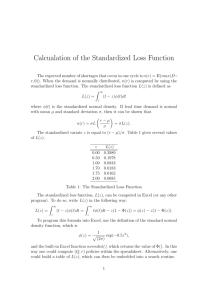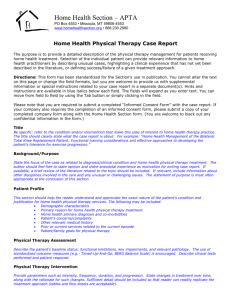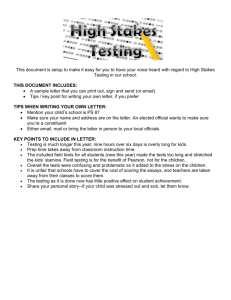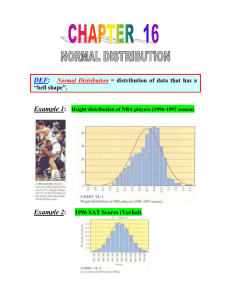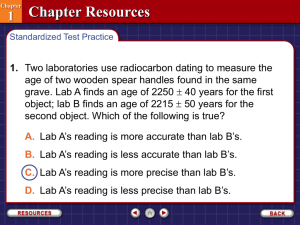Effective Uses of Standardized Testing
advertisement
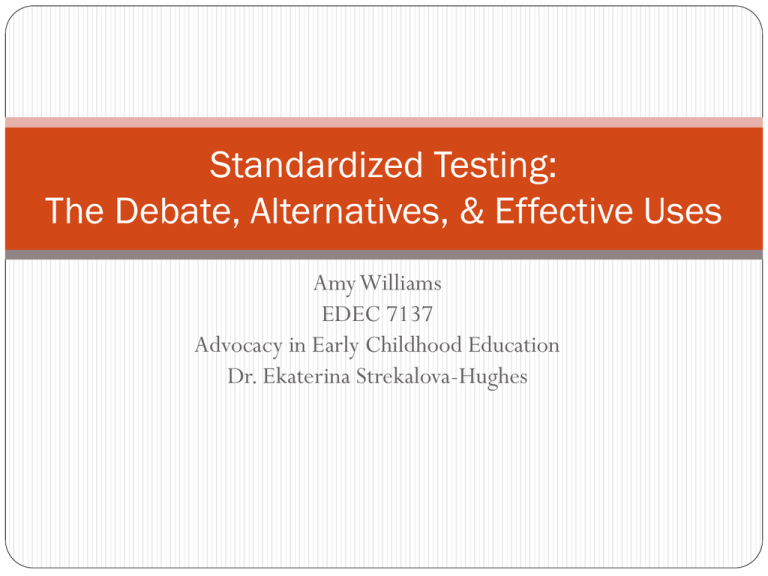
Standardized Testing: The Debate, Alternatives, & Effective Uses Amy Williams EDEC 7137 Advocacy in Early Childhood Education Dr. Ekaterina Strekalova-Hughes Definition A standardized test is any form of test that (1) requires all test takers to answer the same questions, or a selection of questions from common bank of questions, in the same way, and that (2) is scored in a “standard” or consistent manner, which makes it possible to compare the relative performance of individual students or groups of students In addition to the familiar multiple-choice format, standardized tests can include true-false questions, short-answer questions, essay questions, or a mix of question types. *definition taken from www.edglossary.org Intended Uses determine a young child’s readiness for kindergarten to identify students who need special-education services or specialized academic support to place students in different academic programs or course levels to award diplomas and other educational certificates to retain or promote at certain grade levels Examples Achievement tests measure the knowledge and skills students learned in school determine the academic progress they have made over a period of time evaluate the effectiveness of a schools and teachers identify the appropriate academic placement for a student courses or programs academic support Aptitude tests attempt to predict a student’s ability to succeed forecast or predict how well students will do in a future educational or career setting. College Admission tests process of deciding which students will be admitted to a collegiate program used as indicators of intellectual and academic potential International Comparison tests administered periodically to representative samples of students in a number of countries purposes of monitoring achievement trends in individual countries comparing educational performance across countries Psychological tests used to measure a person’s cognitive abilities and mental, emotional, developmental, and social characteristics trained professionals, such as school psychologists, typically administer the tests, which may require students to perform a series of tasks or solve a set of problems. often used to identify students with learning disabilities or other special needs that would qualify them for specialized services. Reform Accountability designed to hold schools and educators accountable for educational results and student performance test scores are used as a measure of effectiveness low scores may trigger a variety of consequences for schools and teachers Student Achievement have students learned what they are expected to learn have students met state learning standards Student Gaps to identify gaps in student learning and academic progress test scores may be used, along with other information about students, to diagnose learning needs Sub-Groups to identify achievement gaps among different student groups, including students of color, students who are not proficient in English, students from low-income households, and students with physical or learning disabilities. exposing and highlighting achievement gaps may be seen as an essential first step in the effort to educate all students well, which can lead to greater public awareness and changes in educational policies and programs Effective Policies to determine whether educational policies are working as intended elected officials and education policy makers may rely on standardized-test results to determine whether their laws and policies are working or not, or to compare educational performance from school to school or state to state elected officials may also use the results to persuade the public and other elected officials that their policies are in the best interest of children and society Debate Do the scores provide accurate, objective, and useful evidence of school, teacher, or student performance? numerical scores on a test are misleading indicators, standardized tests can only evaluate a narrow range of achievement using limited methods Do the tests have inherent biases that may disadvantage certain groups, such as students of color, students who are unfamiliar with American cultural conventions, students who are not proficient in English, or students with disabilities that may affect their performance? It is said that standardized tests “fair” to all students because every student takes the same test and is evaluated in the same way Is the pervasive overuse of testing actually taking up valuable instructional time that could be better spent teaching students more content and skills? the use of standardized tests is not providing valuable information that educators and school leaders can use to improve instructional quality Debate (cont’d) Do math and reading test scores, for example, provide a full and accurate picture of school, teacher, and student performance? One day, one test, one time frame Does the narrow range of academic content evaluated by standardized tests cause teachers to focus too much on test preparation and a few academic subjects (a practice known as “teaching to the test”) Too much time is being spent on testing/testing preparation Do they create conditions that undermine effective education, such as cheating, unhealthy forms of competition, or unjustly negative perceptions of public schooling? Are standardized-test scores, which could potentially be misleading or inaccurate, too limited an instrument to use as a basis for such consequential decisions? What Research Says… Teaching often relies on summative, standardized testing rather than meaningful learning moments (Bennett & Cunningham, 2009). Assessment “drives learning” (Bennett & Cunningham, 2009) However, summative assessment becomes the focus rather than formative assessment that can truly direct learning (i.e. differentiation) Assessment must be “useful” or “fit for purpose” When the perception is different than the intention of which it was developed, strong negative feelings can arise (East, 2015). “Superficial coverage of subject matter and emphasis on basic skills seldom add up to more complex learning; the focus is on the outcomes and evaluation” (Kontovourki & Campis, 2010). With the high level of accountability on high-stakes testing, teachers and schools are striving to ensure the students perform well on the test; what gets tested, gets the most attention (Kontovourki & Campis, 2010). What Research Says…(cont’d) The controversy surrounding standardized testing is heavily based upon whether or not the high-stakes test should be the sole determining factor for retaining/promoting students as well rewarding teachers and schools with money and ratings (Magee & Jones, 2012). Students are “unique” (Magee & Jones, 2012) Assessing student knowledge should not be based upon one test Personnel have little to no training in the area of interpreting test results and the use of test results (Marso & Pigge, 1992). Administrators often do not distribute or review results with their teachers Standardized testing results are not feasible in making classroom decisions (Marso & Pigge, 1992). Results are often not available until many weeks after the tests are administered What Research Says…(cont’d) There are several benefits to standardized testing (Rogers, 2014) Common assessment Providing results to students (providing they understand) can have a positive effect on student achievement Assist in identifying needs for professional development Preparation for test reduces instructional time and can often lead to reducing higher-order thinking skills and replacing them with lowerorder thinking skills (Rogers, 2014). Educators need the following “reliable diagnostic information” – ability to interpret results Assessment needs to be multi-dimensional – measures more than just how well a student performed that day on a single test More time to interpret the results More training on using the results in a meaningful way What Research Says…(cont’d) Teachers can prepare students for a test, get high scores, but not provide a high quality education (Rose, 2015). Success cannot be determined solely by a test score. If so, we would miss the intellectual achievements that aren’t able to be quantified (Rose, 2015). High-stakes tests are causing teachers to focus solely on math and reading and less on the other subject areas Standardized testing was established in the early 20th century as a way to hold educators accountable for what they were teaching (Ryan, 2014) It was a way to appease the community and stakeholders 42% of entering freshman are under-prepared for college level academic work (Saxon & Morante, 2014). What Research Says…(cont’d) Open enrollment causes lower standards set forth by college professors (Saxon & Morante, 2014). Instructional methods/expectations Other factors such as lifestyle and demographics factor into the “readiness factor” (Saxon & Morante, 2014). Assessment is intended to find out if curriculum was taught properly (Wiliam, 2010). Can it really be determined that a student “learned” through a single test score General understanding: the higher the test score, the higher the achievement (Wiliam, 2010) Recommendations Oral Assessments Lower student anxiety, gives multiple opportunities for assessment, increases “risk-taking” and creativity Embed within normal classroom work and high-stakes testing Focus less on content of tests; More on format and use of vocabulary Focus more on test-taking skills Becoming “test-wise” However, don’t stop what you are teaching and teach test-prep only Teach test-taking skills within your current content Work on changing beliefs of individuals Knowledge and beliefs comes from world-views more so than experiences with testing Recommendations Extensive Training Proper training needs to occur within districts and individual schools on how to interpret the results and how to properly use them within the school and classrooms Assessment schedule Create a different schedule so the teachers can get the results back in time and with enough time to interpret and make adjustments to their curriculum and approach Adjust spending areas Spend more money on high-quality professional development and less on test development Provide low-income schools with resources such as social worker and school nurse Provide resources that can off-set some of the issues students deal with due to low-SES status Recommendations Work with high-schools in an effort to prepare students for higher- rigor Placement tests Consider lifestyle factors prior to admission/rejection Improve the test Reduce the number of standards Complexity of the testing language References Bennett, K.R, & Cunningham, A.C. (2009). Teaching formative assessment strategies to preservice teachers: Exploring the use of handheld computing to facilitate the action research process. Journal of Computing in Teacher Education, 25(3), 99-105. East, M. (2014). Coming to terms with innovative high-stakes assessment practice: Teachers’ viewpoints on assessment reform. Language Testing, 32(1), 101-120. Kontovourki, S. & Campis, C. (2010). Meaningful practice: Test prep in a third-grade public school classroom. The Reading Teacher, 64(4), 236-245. Magee, R.G., & Jones, B.D. (2012). An instrument to assess beliefs about standardized testing: Measuring the influence of epistemology on the endorsement of standardized testing. Australian Journal of Educational & Developmental Psychology, 12, 71-82. Marso, R.N., & Pigge, F.L. (1992). Classroom teacher’s perceptions of the extent and effectiveness of their schools’ uses of standardized test results. Rogers, W.T. (2014). Improving the utility of large-scale assessments in Canada. Canadian Journal of Education, 27(3), 6-22. Rose, M. (2015). School reform fails the test. American Scholar, 84(1), 18-30. Ryan, A.M. (2011). From child study to efficiency: District administrators and the use of testing in the Chicago public schools, 1899 to 1928. Paedagogica Historica, 47(3), 341-354. Saxon, D.P., & Morante, E.A. (2014). Effective student assessment and placement: Challenges and recommendations. Journal of Developmental Education, 47(3), 24-31. Wiliam, D. (2010). Standardized testing and school accountability. Educational Psychologist, 45(2), 107122.


